Paper Menu >>
Journal Menu >>
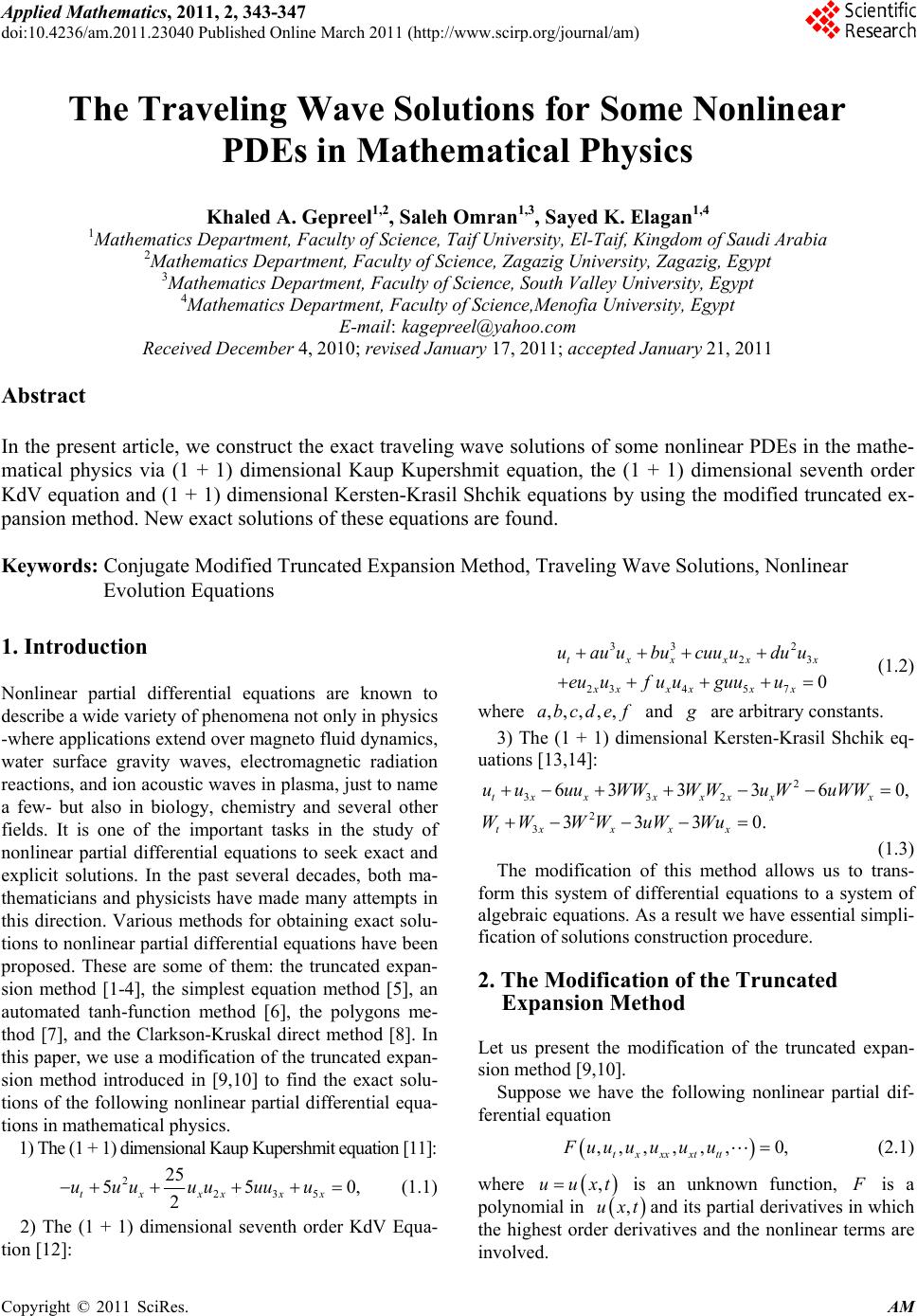 Applied Mathematics, 2011, 2, 343-347 doi:10.4236/am.2011.23040 Published Online March 2011 (http://www.scirp.org/journal/am) Copyright © 2011 SciRes. AM The Traveling Wave Solutions for Some Nonlinear PDEs in Mathematical Physics Khaled A. Gepreel1,2, Saleh Omran1,3, Sayed K. Elagan1,4 1Mathematics Department, Faculty of Science, Taif University, El-Taif, Kingdom of Saudi Arabia 2Mathematics Department, Faculty of Science, Zagazig University, Zagazig, Egypt 3Mathematics Department, Faculty of Science, South Valley University, Egypt 4Mathematics Department, Faculty of Science,Menofia University, Egypt E-mail: kagepreel@yahoo.com Received December 4, 2010; revised January 17, 2011; accepted January 21, 201 1 Abstract In the present article, we construct the exact traveling wave solutions of some nonlinear PDEs in the mathe- matical physics via (1 + 1) dimensional Kaup Kupershmit equation, the (1 + 1) dimensional seventh order KdV equation and (1 + 1) dimensional Kersten-Krasil Shchik equations by using the modified truncated ex- pansion method. New exact solutions of these equations are found. Keywords: Conjugate Modified Truncated Expansion Method, Traveling Wave Solutions, Nonlinear Evolution Equations 1. Introduction Nonlinear partial differential equations are known to describe a wide variety of phen omena not only in physics -where applications extend over magneto fluid dynamics, water surface gravity waves, electromagnetic radiation reactions, and ion acoustic waves in plasma, just to name a few- but also in biology, chemistry and several other fields. It is one of the important tasks in the study of nonlinear partial differential equations to seek exact and explicit solutions. In the past several decades, both ma- thematicians and physicists have made many attempts in this direction. Various methods for obtaining exact solu- tions to nonlinear partial differential equations have been proposed. These are some of them: the truncated expan- sion method [1-4], the simplest equation method [5], an automated tanh-function method [6], the polygons me- thod [7], and the Clarkson-Kruskal direct method [8]. In this paper, we use a modification of the truncated expan- sion method introduced in [9,10] to find the exact solu- tions of the following nonlinear partial differential equa- tions in mathematical physics. 1) The (1 + 1) di mensional Kaup Kupershm it equation [11]: 2235 25 550, 2 txxxxx uuuuuuuu (1.1) 2) The (1 + 1) dimensional seventh order KdV Equa- tion [12]: 33 2 23 23457 0 txxxx x xxxxx x uauubucuuu duu euuf uuguuu (1.2) where ,,,,,abcde f and g are arbitrary constants. 3) The (1 + 1) dimensional Kersten-Krasil Shchik eq- uations [13,14]: 2 332 2 3 6333 60, 3330. txxxxx xx txx x x uuuuWWW Wu WuWW WWWWuW Wu (1.3) The modification of this method allows us to trans- form this system of differential equations to a system of algebraic equations. As a result we have essential simpli- fication of solutions construction procedure. 2. The Modification of the Truncated Expansion Method Let us present the modification of the truncated expan- sion method [9,10]. Suppose we have the following nonlinear partial dif- ferential equation ,,,,, ,0, txxxxttt Fuuu uuu (2.1) where ,uuxt is an unknown function, F is a polynomial in ,uxtand its partial derivatives in which the highest order derivatives and the nonlinear terms are involved. 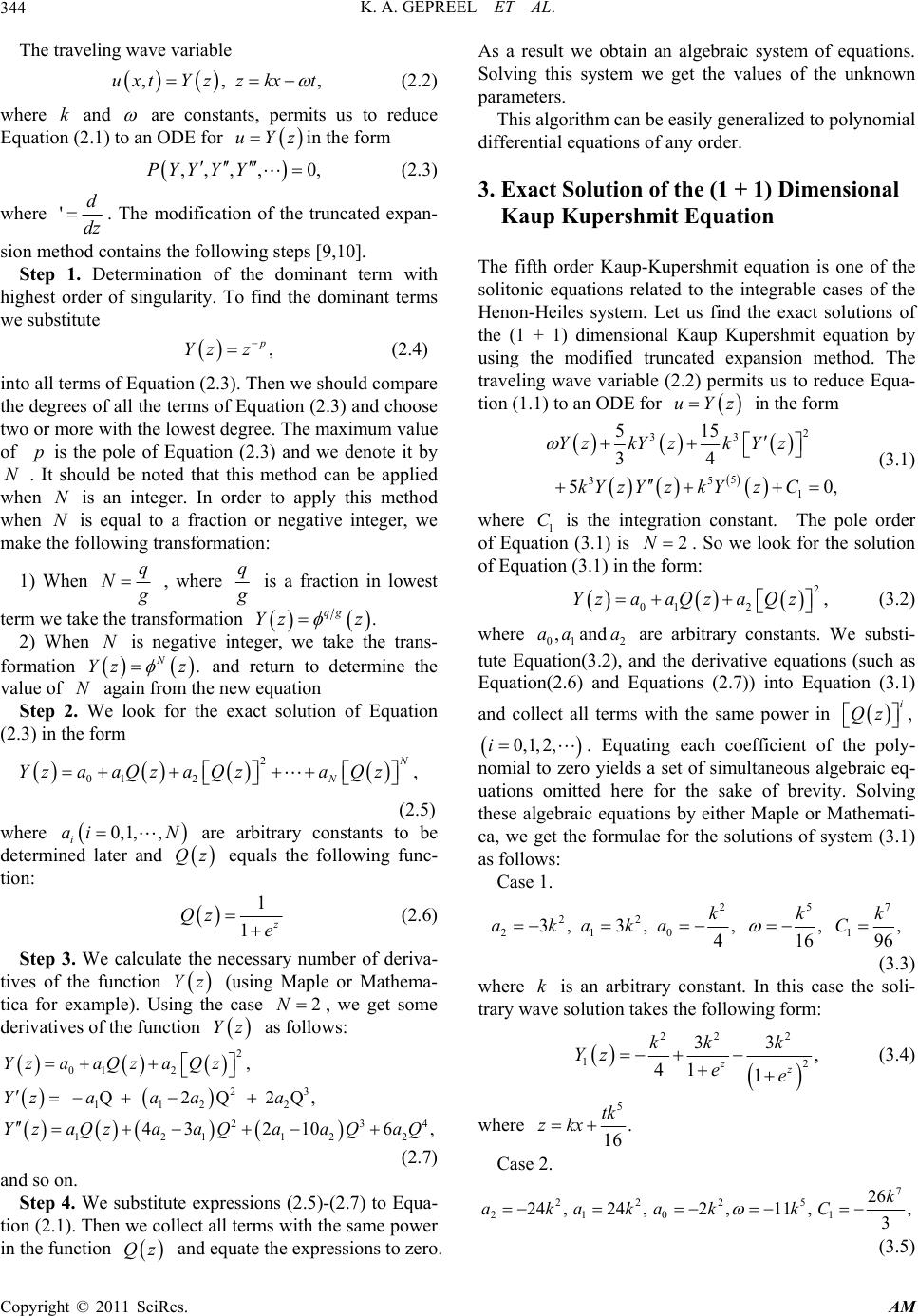 K. A. GEPREEL ET AL. Copyright © 2011 SciRes. AM 344 The traveling wave variable ,, ,uxtYzz kxt (2.2) where k and are constants, permits us to reduce Equation (2.1) to an ODE for uYzin the form ,,,,0,PYY YY (2.3) where 'd dz . The modification of the truncated expan- sion method contains the following steps [9,10]. Step 1. Determination of the dominant term with highest order of singularity. To find the dominant terms we substitute , p Yz z (2.4) into all terms of Equation (2.3). Then we should compare the degrees of all the terms of Equation (2.3) and choose two or more with the lowest degree. The maximum value of p is the pole of Equation (2.3) and we denote it by N . It should be noted that this method can be applied when N is an integer. In order to apply this method when N is equal to a fraction or negative integer, we make the following transformation: 1) When q N g , where q g is a fraction in lowest term we take the transformation . qg Yz z 2) When N is negative integer, we take the trans- formation . N Yz z and return to determine the value of N again from the new equation Step 2. We look for the exact solution of Equation (2.3) in the form 2 01 2, N N YzaaQza QzaQz (2.5) where 0,1, , i ai N are arbitrary constants to be determined later and Qz equals the following func- tion: 1 1 z Qz e (2.6) Step 3. We calculate the necessary number of deriva- tives of the function Yz (using Maple or Mathema- tica for example). Using the case 2N, we get some derivatives of the fu nct i o n Yz as follows: 2 01 2 23 1122 234 121122 , Q 2Q 2Q, 432106, YzaaQza Qz Yzaa aa Yz aQzaaQaaQaQ (2.7) and so on. Step 4. We substitute expressions (2.5)-(2.7) to Equa- tion (2.1). Then we collect all terms with the same power in the function Qz and equate the expressions to zero. As a result we obtain an algebraic system of equations. Solving this system we get the values of the unknown parameters. This algorithm can be easily generalized to po lynomial differential equations of any order. 3. Exact Solution of the (1 + 1) Dimensional Kaup Kupershmit Equation The fifth order Kaup-Kupershmit equation is one of the solitonic equations related to the integrable cases of the Henon-Heiles system. Let us find the exact solutions of the (1 + 1) dimensional Kaup Kupershmit equation by using the modified truncated expansion method. The traveling wave variable (2.2) permits us to reduce Equa- tion (1.1) to an ODE for uYz in the form 2 33 5 35 1 515 34 50, YzkYzkYz kY zYzkYzC (3.1) where 1 C is the integration constant. The pole order of Equation (3.1) is 2N . So we look for the solution of Equation (3.1) in the form: 2 01 2,YzaaQza Qz (3.2) where 01 ,aaand 2 a are arbitrary constants. We substi- tute Equation(3.2), and the derivative equations (such as Equation(2.6) and Equations (2.7)) into Equation (3.1) and collect all terms with the same power in , i Qz 0,1,2,i. Equating each coefficient of the poly- nomial to zero yields a set of simultaneous algebraic eq- uations omitted here for the sake of brevity. Solving these algebraic equations by either Maple or Mathemati- ca, we get the formulae for the solutions of system (3.1) as follows: Case 1. 257 22 210 1 3, 3,,,, 41696 kkk akaka C (3.3) where k is an arbitrary constant. In this case the soli- trary wave solution takes the following form: 22 2 12 33 , 411 zz kk k Yz ee (3.4) where 5. 16 tk zkx Case 2. 7 22 2 5 210 1 26 24 ,24 ,2 ,11,, 3 k akakak kC (3.5) 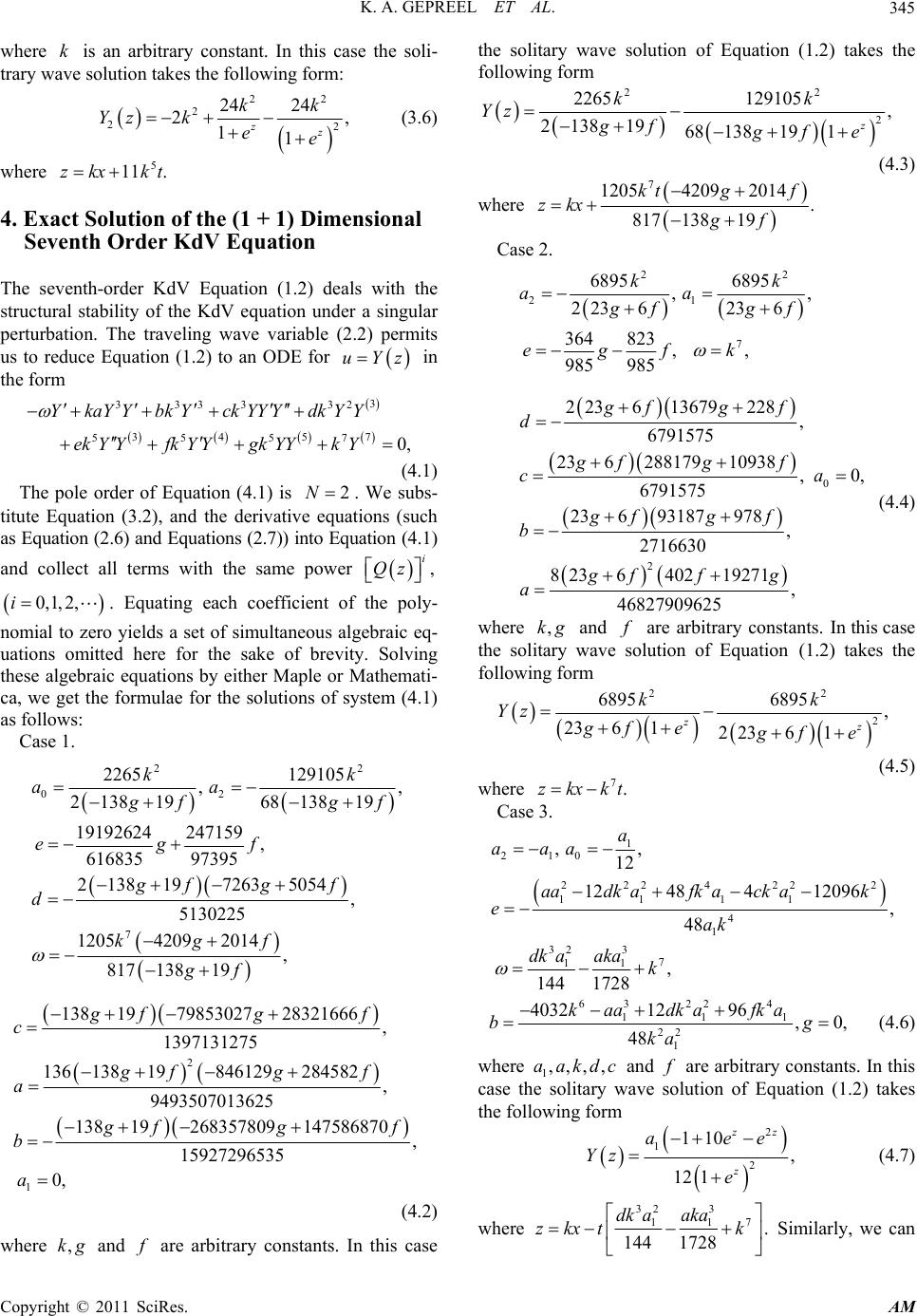 K. A. GEPREEL ET AL. Copyright © 2011 SciRes. AM 345 where k is an arbitrary constant. In this case the soli- trary wave solution takes the following form: 22 2 22 24 24 2, 11 zz kk Yz kee (3.6) where 5 11 .zkx kt 4. Exact Solution of the (1 + 1) Dimensional Seventh Order KdV Equation The seventh-order KdV Equation (1.2) deals with the structural stability of the KdV equation under a singular perturbation. The traveling wave variable (2.2) permits us to reduce Equation (1.2) to an ODE for uYz in the form 3 3333 32 3457 5557 0, YkaYYbkY ckYYYdkYY ek YYfk YYgk YYk Y (4.1) The pole order of Equation (4.1) is 2N. We subs- titute Equation (3.2), and the derivative equations (such as Equation (2.6) and Equations (2.7)) into Equation (4. 1) and collect all terms with the same power , i Qz 0,1,2,i. Equating each coefficient of the poly- nomial to zero yields a set of simultaneous algebraic eq- uations omitted here for the sake of brevity. Solving these algebraic equations by either Maple or Mathemati- ca, we get the formulae for the solutions of system (4.1) as follows: Case 1. 22 02 7 2265 129105 ,, 2138 196813819 19192624247159, 616835 97395 2 1381972635054, 5130225 120542092014 , 817 13819 kk aa g fgf egf gfgf d kgf gf 2 1 138197985302728321666 , 1397131275 136 13819846129284582, 9493507013625 13819268357809147586870 , 15927296535 0, gfg f c gfg f a g fgf b a (4.2) where ,kg and f are arbitrary constants. In this case the solitary wave solution of Equation (1.2) takes the following form 22 2 2265129105 , 2 1381968138191z kk Yz gf gf e (4.3) where 7 120542092014 . 817 13819 kt gf zkx gf Case 2. 22 21 7 6895 6895 ,, 223 623 6 364823 ,, 985 985 kk aa g fgf egfk 0 2 223 6 13679228, 6791575 23628817910938 ,0, 6791575 23693187978, 2716630 8 23640219271, 46827909625 gfgf d gfgf ca gfg f b gf fg a (4.4) where ,kg and f are arbitrary constants. In this case the solitary wave solution of Equation (1.2) takes the following form 22 2 68956895 , 2361 22361 zz kk Yz gf egf e (4.5) where 7.zkxkt Case 3. 1 210 2224 222 1111 4 1 323 7 11 ,, 12 1248412096 , 48 , 144 1728 a aaa aadk afk ack ak eak dk aakak 63 224 111 22 1 40321296 ,0, 48 kaa dkafka bg ka (4.6) where 1,,,,aakdc and f are arbitrary constants. In this case the solitary wave solution of Equation (1.2) takes the following form 2 1 2 110 , 12 1 zz z aee Yz e (4.7) where 323 7 11. 144 1728 dk aaka zkxt k Similarly, we can 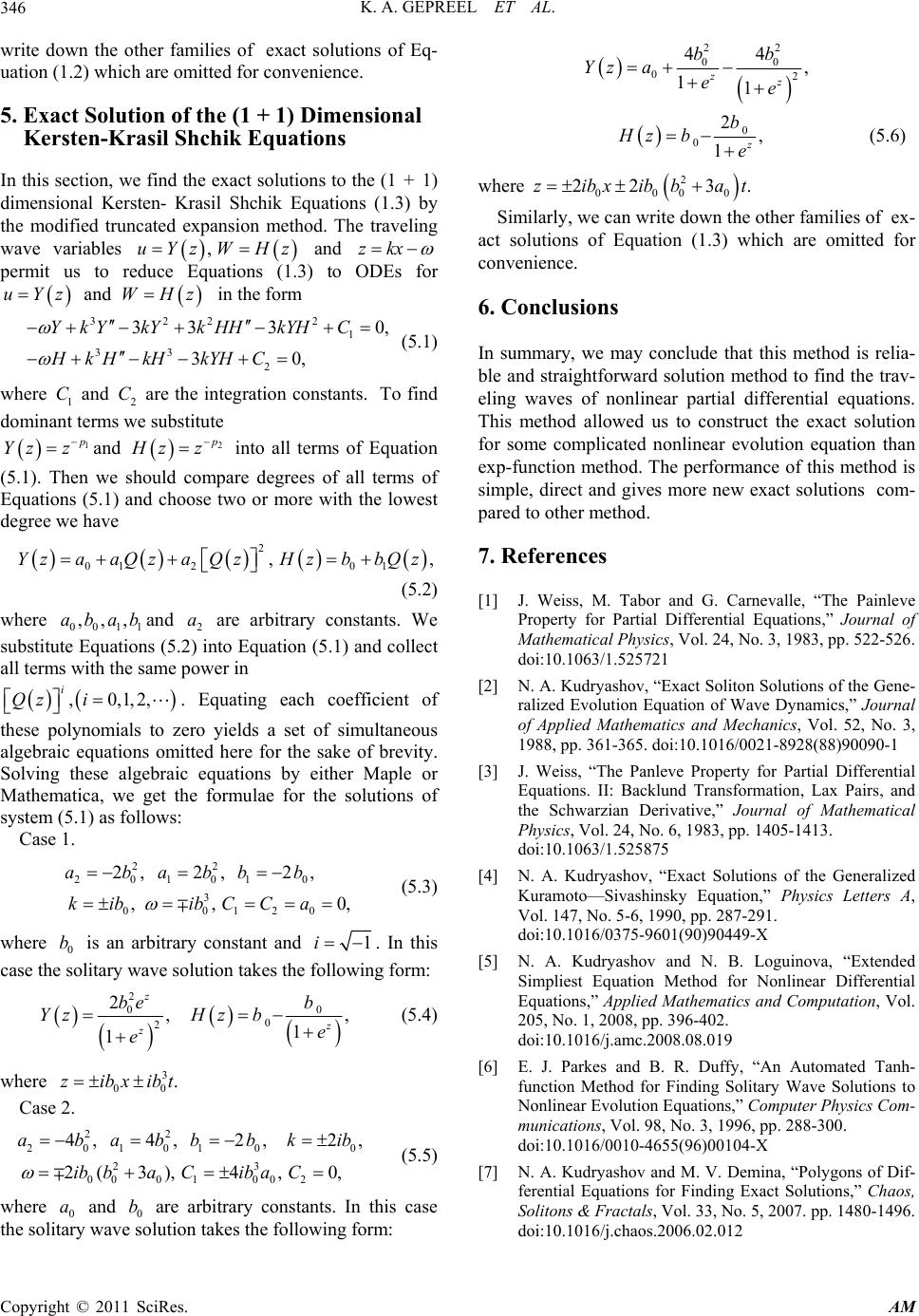 K. A. GEPREEL ET AL. Copyright © 2011 SciRes. AM 346 write down the other families of exact solutions of Eq- uation (1.2) which are omitted for convenience. 5. Exact Solution of the (1 + 1) Dimensional Kersten-Krasil Shchik Equations In this section, we find the exact solutions to the (1 + 1) dimensional Kersten- Krasil Shchik Equations (1.3) by the modified truncated expansion method. The traveling wave variables ,uYzWHz and zkx permit us to reduce Equations (1.3) to ODEs for uYz and WHz in the form 322 2 1 33 2 33 30, 30, YkYkYkHHkYH C HkH kHkYHC (5.1) where 1 C and 2 C are the integration constants. To find dominant terms we substitute 1 p Yz z and 2 p H zz into all terms of Equation (5.1). Then we should compare degrees of all terms of Equations (5.1) and choose two or more with the lowest degree we have 2 01 201 ,,YzaaQza QzHzbbQz (5.2) where 0011 ,,,ababand 2 a are arbitrary constants. We substitute Equations (5 .2) into Equation (5.1) and collect all terms with the same power in ,0,1,2, i Qz i . Equating each coefficient of these polynomials to zero yields a set of simultaneous algebraic equations omitted here for the sake of brevity. Solving these algebraic equations by either Maple or Mathematica, we get the formulae for the solutions of system (5.1) as follows: Case 1. 22 201010 3 00120 2, 2,2, ,, 0, ababbb kib ibCCa (5.3) where 0 b is an arbitrary constant and 1i. In this case the solitary wave solution takes the following form: 2 00 0 2 2,, 1 1 z z z be b YzHz be e (5.4) where 3 00 .zibxibt Case 2. 22 201010 0 23 000100 2 4,4,2,2 , 2( 3),4,0, ababbbkib ibbaCib aC (5.5) where 0 a and 0 b are arbitrary constants. In this case the solitary wave solution takes the following form: 22 00 02 44 , 11 zz bb Yz aee 0 02, 1z b Hz be (5.6) where 2 0000 22 3.zibxibbat Similarly, we can write down the other families of ex- act solutions of Equation (1.3) which are omitted for convenience. 6. Conclusions In summary, we may conclude that this method is relia- ble and straightforward solution method to find the trav- eling waves of nonlinear partial differential equations. This method allowed us to construct the exact solution for some complicated nonlinear evolution equation than exp-function method. The performance of this method is simple, direct and gives more new exact solutions com- pared to other method. 7. References [1] J. Weiss, M. Tabor and G. Carnevalle, “The Painleve Property for Partial Differential Equations,” Journal of Mathematical Physics, Vol. 24, No. 3, 1983, pp. 522-526. doi:10.1063/1.525721 [2] N. A. Kudryashov, “Exact Soliton Solutions of the Gene- ralized Evolution Equation of Wave Dynamics,” Journal of Applied Mathematics and Mechanics, Vol. 52, No. 3, 1988, pp. 361-365. doi:10.1016/0021-8928(88)90090-1 [3] J. Weiss, “The Panleve Property for Partial Differential Equations. II: Backlund Transformation, Lax Pairs, and the Schwarzian Derivative,” Journal of Mathematical Physics, Vol. 24, No. 6, 1983, pp. 1405-1413. doi:10.1063/1.525875 [4] N. A. Kudryashov, “Exact Solutions of the Generalized Kuramoto—Sivashinsky Equation,” Physics Letters A, Vol. 147, No. 5-6, 1990, pp. 287-291. doi:10.1016/0375-9601(90)90449-X [5] N. A. Kudryashov and N. B. Loguinova, “Extended Simpliest Equation Method for Nonlinear Differential Equations,” Applied Mathematics and Computation, Vol. 205, No. 1, 2008, pp. 396-402. doi:10.1016/j.amc.2008.08.019 [6] E. J. Parkes and B. R. Duffy, “An Automated Tanh- function Method for Finding Solitary Wave Solutions to Nonlinear Evolution Equations,” Computer Physics Com- munications, Vol. 98, No. 3, 1996, pp. 288-300. doi:10.1016/0010-4655(96)00104-X [7] N. A. Kudryashov and M. V. Demina, “Polygons of Dif- ferential Equations for Finding Exact Solutions,” Chaos, Solitons & Fractals, Vol. 33, No. 5, 2007. pp. 1480-1496. doi:10.1016/j.chaos.2006.02.012 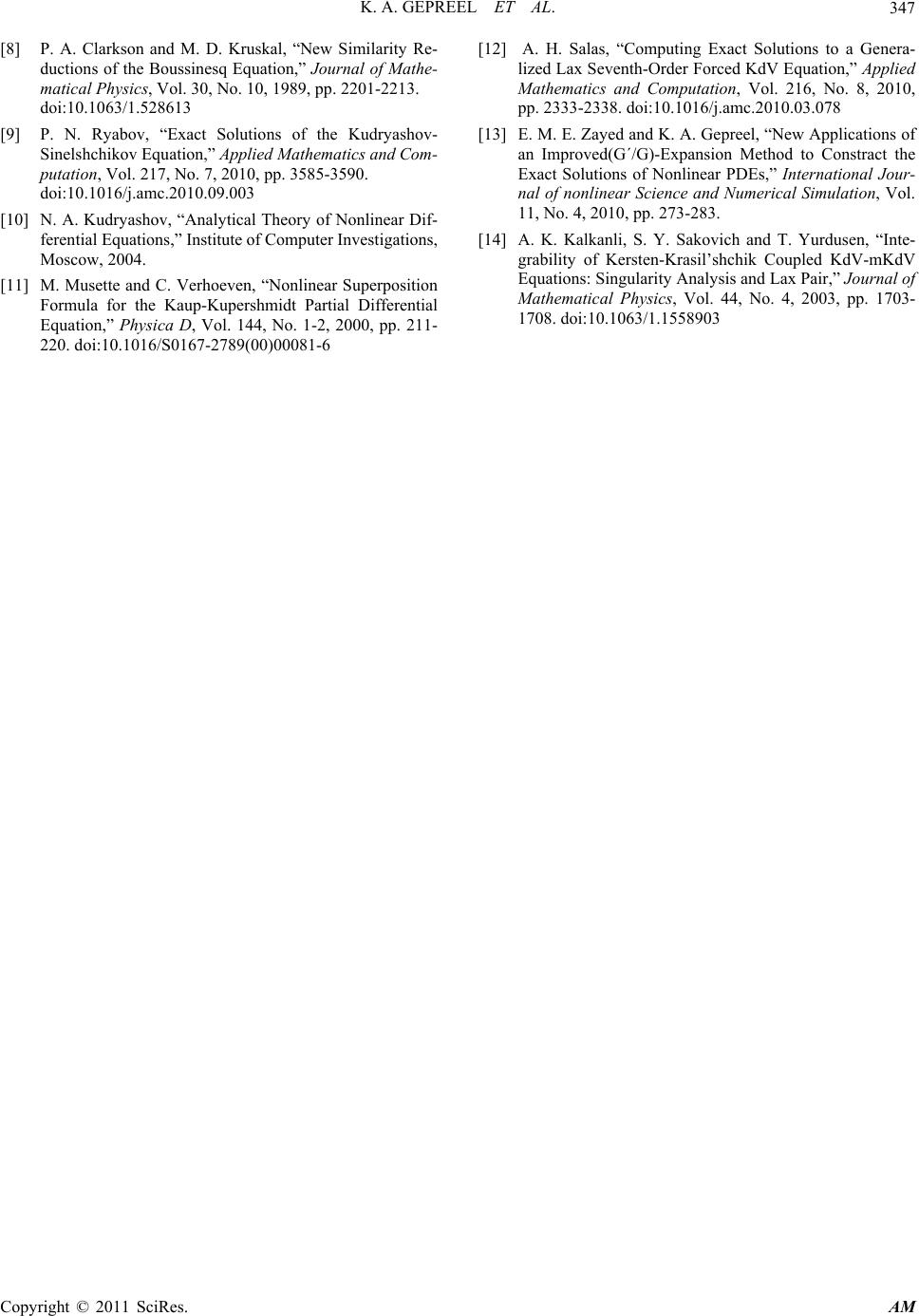 K. A. GEPREEL ET AL. Copyright © 2011 SciRes. AM 347 [8] P. A. Clarkson and M. D. Kruskal, “New Similarity Re- ductions of the Boussinesq Equation,” Journal of Mathe- matical Physics, Vol. 30, No. 10, 1989, pp. 2201-2213. doi:10.1063/1.528613 [9] P. N. Ryabov, “Exact Solutions of the Kudryashov- Sinelshchikov Equation,” Applied Mathe ma t ic s a nd Co m- putation, Vol. 217, No. 7, 2010, pp. 3585-3590. doi:10.1016/j.amc.2010.09.003 [10] N. A. Kudryashov, “Analytical Theory of Nonlinear Dif- ferential Equations,” Institute of Com puter Inve stigations, Moscow, 2004. [11] M. Musette and C. Verhoeven, “Nonlinear Superposition Formula for the Kaup-Kupershmidt Partial Differential Equation,” Physica D, Vol. 144, No. 1-2, 2000, pp. 211- 220. doi:10.1016/S0167-2789(00)00081-6 [12] A. H. Salas, “Computing Exact Solutions to a Genera- lized Lax Seventh-Order Forced KdV Equation,” Applied Mathematics and Computation, Vol. 216, No. 8, 2010, pp. 2333-2338. doi:10.1016/j.amc.2010.03.078 [13] E. M. E. Zayed and K. A. Gepreel, “New Applications of an Improved(G´/G)-Expansion Method to Constract the Exact Solutions of Nonlinear PDEs,” International Jour- nal of nonlinear Science and Numerical Simulation, Vol. 11, No. 4, 2010, pp. 273-283. [14] A. K. Kalkanli, S. Y. Sakovich and T. Yurdusen, “Inte- grability of Kersten-Krasil’shchik Coupled KdV-mKdV Equations: Singularity Analysis and Lax Pair,” Journal of Mathematical Physics, Vol. 44, No. 4, 2003, pp. 1703- 1708. doi:10.1063/1.1558903 |

